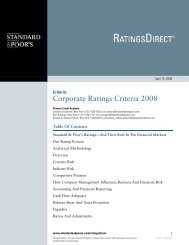European Infrastructure Finance Yearbook - Investing In Bonds ...
European Infrastructure Finance Yearbook - Investing In Bonds ...
European Infrastructure Finance Yearbook - Investing In Bonds ...
Create successful ePaper yourself
Turn your PDF publications into a flip-book with our unique Google optimized e-Paper software.
irrespective of whether the monoline guarantee<br />
applies to all the project debt or only a portion<br />
of it.<br />
Standard & Poor’s relies only on in-house<br />
determinations of default frequency and recovery<br />
estimates. Ratings and recovery values estimated<br />
by other rating agencies or professional bodies are<br />
not used as reference points for assigning the<br />
capital charge. The in-house data enable<br />
Standard & Poor’s to maintain consistency<br />
across various jurisdictions, transactions, and<br />
operating environments.<br />
Calculating The Capital Charge<br />
Default frequency<br />
The default frequency for a given rating is<br />
determined using Standard & Poor’s corporate<br />
default study. The default study identifies the<br />
highest historical default rates across various<br />
sectors by rating category over a period of years.<br />
The leading global economies, the U.S. and<br />
Europe, have not, over the past 15 years,<br />
represented a worst-case depression-like scenario,<br />
and so the default rates are grossed up to what<br />
Standard & Poor’s believes to be worst-case<br />
levels. Through simulations of such scenarios<br />
across various sectors, Standard & Poor’s<br />
calculates worst-case default frequency for longterm<br />
risks across the rating categories (see table).<br />
Worst-Case Default Frequency<br />
Rating category Worst-case default frequency (%)<br />
AA 5.9<br />
A 7.1<br />
BBB 14.8<br />
BB 55.4<br />
Loss-given default<br />
Loss-given default is unique for each project, for<br />
the reasons given in “Defining The Capital<br />
Charge”. It can differ between two assets in the<br />
same sector and jurisdiction. There can also be<br />
different degrees of confidence regarding recovery.<br />
Subjective judgments are critical for deciding how<br />
to stress collateral values in hypothetical postdefault<br />
scenarios, but market trends can<br />
supplement theoretical estimates. For the purposes<br />
of assigning a capital charge, Standard & Poor’s<br />
currently assumes a maximum recovery of 90%.<br />
STANDARD & POOR’S EUROPEAN INFRASTRUCTURE FINANCE YEARBOOK<br />
PROJECT FINANCE/PUBLIC-PRIVATE PARTNERSHIPS<br />
Example.<br />
This example gives an illustration of how the<br />
capital charge on a project rated ‘A’ is determined.<br />
The steps are: to determine the ‘A’ underlying<br />
rating on the project; read the default frequency<br />
from the table above; estimate the loss-given<br />
default; and finally determine the<br />
capital charge.<br />
• The project’s underlying rating is ‘A’.<br />
• The default frequency for the ‘A’ rating<br />
category is 7.1%.<br />
• The estimated asset recovery value is 60%.<br />
• The loss-given default is 40% (100%<br />
minus 60%).<br />
• The capital charge is 7.1% multiplied by<br />
40%: 2.84% of par value.<br />
Cross-border issuance<br />
Projects located in one country often raise debt in<br />
another market. Such situations give rise to<br />
sovereign-related risks that could affect the ability<br />
and willingness of the entity to service its foreign<br />
currency debt. <strong>In</strong> the past, we adjusted capital<br />
charges to reflect these risks. Effective this year,<br />
however, our methodology for calculating capital<br />
charges for project cross-border issuance has<br />
been revised.<br />
Based on evidence that sovereigns under<br />
political and economic stress are less often<br />
restricting nonsovereign entities’ access to the<br />
foreign exchange needed for debt service, crossborder<br />
transactions (even without structural<br />
sovereign risk mitigation features) can be rated<br />
above the sovereign foreign currency rating, up to<br />
the “Transfer and Convertibility Risk<br />
Assessment” for the relevant sovereign<br />
jurisdiction. Project ratings incorporate all<br />
transfer and convertibility risk and other relevant<br />
country risks. Furthermore, many cross-border<br />
project finance transactions contain significant<br />
additional structural mitigants for direct sovereign<br />
interference risk, which make an additional<br />
“sovereign risk” adjustment to the capital<br />
charge unnecessary.<br />
Our new methodology for setting the capital<br />
charge for cross-border project finance<br />
transactions is therefore based on the default rate<br />
associated with the transaction’s foreign currency<br />
rating and severity of loss-given default. The latter<br />
will continue to be an analytical assessment based<br />
on the unique characteristics of each individual<br />
transaction analyzed by Standard & Poor’s.<br />
NOVEMBER 2007 ■ 127



